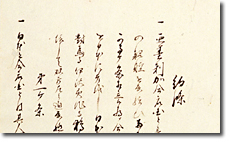HOME > Initial Steps toward a Constitutional State > a. Conceptions of the Form of Government circa the Meiji Restoration > Opening of the Country - Dawn of the Modern Era
1-1 Opening of the Country - Dawn of the Modern Era

Perry Torai Ezu Harimaze Byobu (Collection of the Historiographical Institute, the University of Tokyo)
On July 8 (lunar June 3) of 1853 (Ka'ei 6), the U.S. East India Fleet, led by Commodore Matthew Calbraith PERRY, dropped anchor off Uraga in Edo (Tokyo) Bay, and asked the Japanese to accept a missive from President Millard FILLMORE addressed to the Japanese Emperor relating to U.S.-Japanese amity and commercial traffic. Councilor ABE Masahiro had the President's missive translated along with related documents, and presented them to a number of daimyo to solicit their opinions. In March (lunar February) of 1854 (Ka'ei 7), PERRY once again paid a visit to Japan and started talks with Shogunate representatives, led by Daigaku-no-kami (University President) HAYASHI Fukusai, in the village of Yokohama. After multiple negotiations, the twelve article U.S.-Japan Treaty of Peace and Amity was signed by the two nations, specifying permanent and everlasting peace and amity, opening of the ports of Shimoda and Hakodate, supply of firewood and water, and permission to station consulates, etc. In addition, in June (lunar May) of 1854 (Ka'ei 7), the thirteen clause appendix to the Treaty was agreed upon. The Treaty came into force on February 21 (lunar January 5) of 1855 (Ansei 2) with the exchange of ratified copies, formally ending Japan's policy of seclusion.
The "Gasshukoku Shokan Wage" (Translations of Letters from the United States [President]) comprises five copies of documents in classical Chinese, including President. FILLMORE's missive, along with their Japanese translations. The other document is the copy of the U.S.-Japan Treaty of Peace and Amity ratified by Japan; there is also a ratified copy of the Treaty Appendix, although that document did not actually need ratification. This is also referred to in PERRY's Narrative of the Expedition to the China Seas and Japan, 1852-1854.
"Gasshukoku Shokan Wage" ('Translations of Letters from the United States [President]')
- 1853 (Ka'ei 6)
- Papers of SANJO Family, #2-22
- National Diet Library
Copy of the U.S.-Japan Treaty of Peace and Amity
- 1855 (lunar December of Ansei 1)
- Papers of SANJO Family, #3-49
- National Diet Library
![(Gasshukoku Shokan Wage) ('Translations of Letters from the United States [President]')](/modern/thumb/main_thumb/001-002t.jpg)
